Last Updated on June 19, 2024
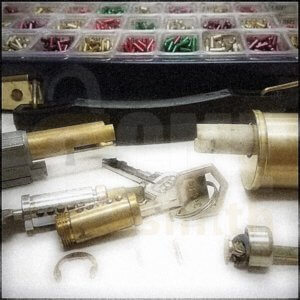
Which is Cheaper? Rekey or Replace Locks? | How Locks Work | How a Key Opens a lock | How Lock Pins Stop the Wrong Key from Working | What is Master Rekeying | Rekeying Locks to a Current Key | DIY – Lock Rekeying | How to Rekey a Kwikset Smarkey Lock
A lock rekey means replacing a lock’s internal pins to make current keys ineffective. Instead, a new key now opens the lock. This process eliminates the need for lock replacement when moving into a new home, and enhances security by preventing access with previous keys. Locksmiths commonly offer this service.
Benefits of Lock Rekeying
The benefit of lock rekeying is security. You will prevent anyone that had a working key to your lock, prior to rekeying, from having a working key after rekeying. Lock rekeying is an excellent thing to do when you have purchased a new home.
Also, if you’ve lost your key and you believe that someone may be able to tie that key to your home, then you’ll want to rekey the house. Say for example, you leave a copy of your key in your car and your car has been broken into our stolen, get a rekey.
Is it Cheaper to Rekey or Replace Locks?
Rekeying a lock is always cheaper than buying a new lock. You can save up to 10X by rekeying existing door hardware rather than buying new locks, because you are not replacing the door hardware. The savings becomes more substantial as the number of locks increases. To save the most money take your locks into a locksmith shop, such as our Phoenix location, you’ll avoid the cost of a service call.
How Do Locks Work?
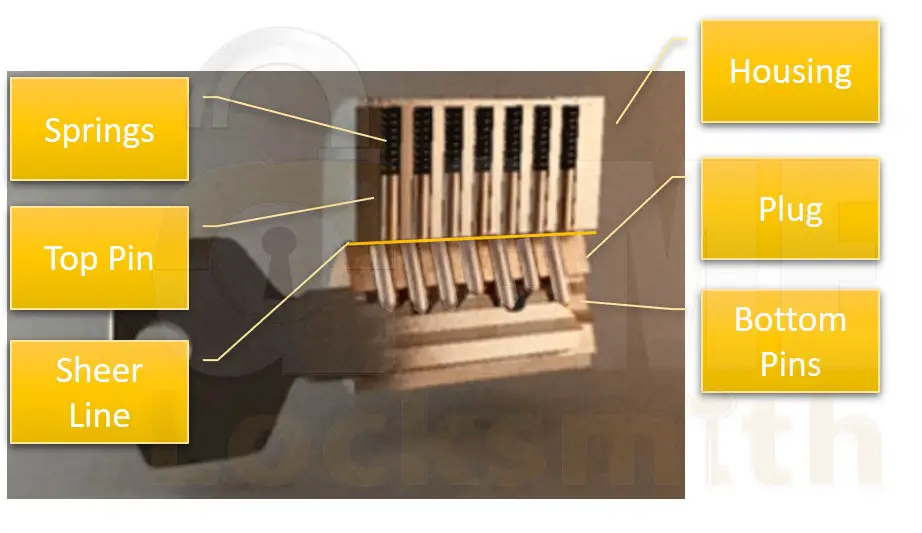
To understand how lock rekeying works, you need to have a little knowledge of how a lock cylinder is put together. Although every lock is a bit different, most common home and business locks have the same basic parts.
Components of a Lock
There is the lock housing, which is what surrounds the cylinder and holds it in. The cylinder (sometimes referred to as a plug) fits snug into the housing. It is held in place with some form of clip, cam, or nut that keeps it from being pulled out. Pictured here is a key-in-knob cylinder (the kind you would find in a door know or lever).
The lock housing and the cylinder both contain holes. These holes accommodate “bottom pins” like those shown in the photo. Those are the pins that come in contact with your key.
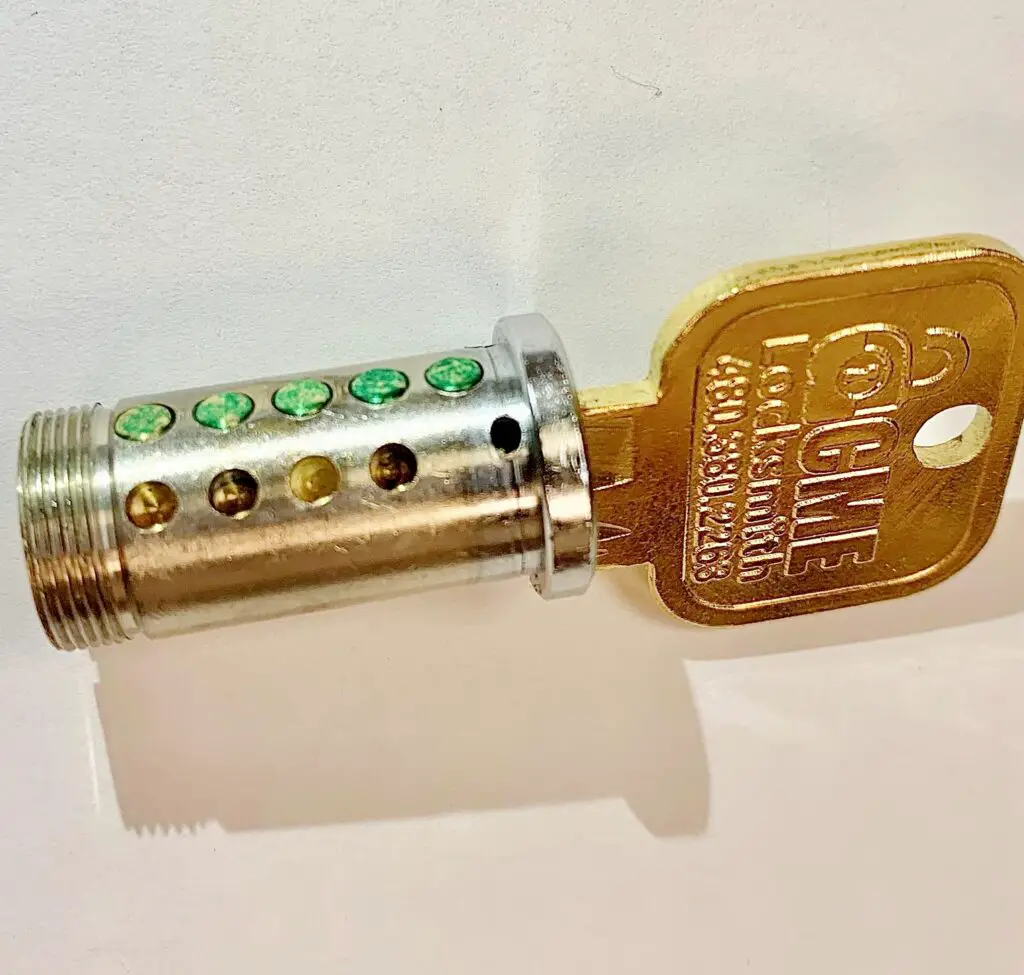
Lock Pins Determine the Key Used
The bumps that are cut into the key will raise the key pins inside of the cylinder (shown in green) so that the key pins are flush with the cylinder. This is creates a shear line that allows the cylinder to rotate.
When the bottom pins are flush, the cylinder can spin (rotate). That is how the correct key opens the door.
How Do the Lock Pins Stop a Lock from Opening?
There are also pins, call top pins, that are within the lock housing itself.
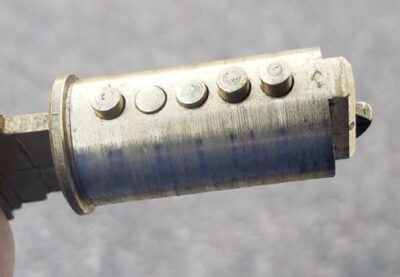
When the key is not in the keyhole, the pins within the cylinder are in a down position and the top pins of the housing slide down into the cylinder holes. The top pins are actually pushed into the cylinder.
These pins block the shear line and prevent the plug from spinning freely. This prevents something like, say, a screwdriver from opening the lock.
These 3 items (bottom pins, top pins, and springs) are secured either internally or with a spring cap, to keep everything held together.
When the wrong key is inserted into the lock, some of the pins will be below the cylinder’s shear line, and some will be raised above it (pushed into the holes for the top pins). Both of these situations block shear line so that the wrong key can’t open the lock.
Can You Rekey a Lock Without Replacing the Lock?
You can rekey a lock without replacing the lock by changing the internal pins. Changing the internal pin length results in the old key no longer aligning the pins to the shear line. A new key will need to be make to align the new pins to the shear line and open the lock.
What is Master Keying?
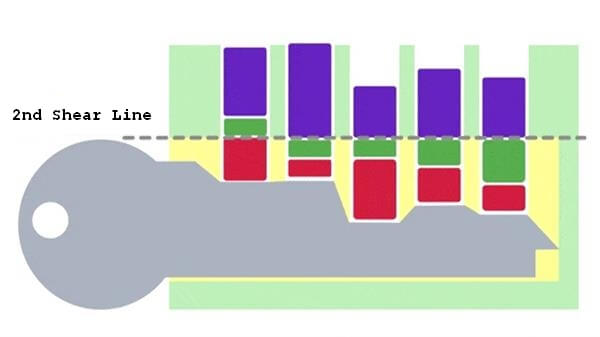
Instead of having one pin in each top pin location, you can create a stack of pins with 2 or more key pins. This will create a cylinder that has multiple shear lines.
That is, more than one cut key will create a shear line, so more than one key will open the lock.
This is called ‘master keying.’
Master keying is the process of rekeying a lock with multiple top pins so that the lock can be opened with more than one key. Master keying and is used in businesses extensively. For example, one person might have a key that accesses all of the office doors, but another’s key will only open their office door.
Check out our article “What is Master Keying?”
How to Rekey a Lock to Match a Current Key
Many times the need to rekey a lock is for a new lock that was purchased to replace a existing lock on the home. You want that new lock to use the same key that you already have.
This is no problem, so long as you buy a lock that is the same keyway as your existing locks. The easiest way to ensure this is to buy the same brand of lock from the same manufacturer.
But there are different lock brands that use the same keyway, so it’s not always necessary to get the same brand. In fact, if you are upgrading to electronic locks, the one you want could very likely be an off brand. See our article Rekeying Locks to Match Existing House Keys to ensure you get a lock that uses the same type of keyway.
How to Rekey Your Own Locks – DIY
Taking your own locks into a lock shop is one of the most affordable ways to rekey your own locks. See our article, “How Much Does it Cost to Rekey Locks?” But if you’re the type that wants to figure it out and pay the absolute minimum, then rekeying your own locks may be for you.
You can rekey your own locks by removing the lock from the door, taking out the cylinder and then replacing the bottom pins. But, as a practical matter, it may not be worth it. A single mistake can make the springs and pins fly out, all over the place, and you’ll need a professional locksmith to get it all back together or to replace the lock.
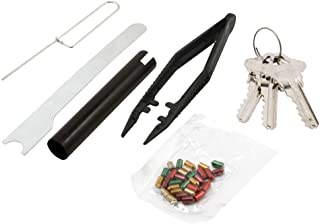
We’ve often had folks who’ve tried to go it alone come into our store when something goes wrong.
If you are willing to take on the challenge, you can buy an inexpensive rekey kits on Amazon. This is really a case where you need the right tools for the job and a rekey kit is a quick and affordable way to get them.
If you are handy, it could be fun to try to re key the lock yourself. If it works, great! If not, just take the locks into a local locksmith shop and they’ll get it back together for you.
How to Rekey Kwikset SmartKey Locks
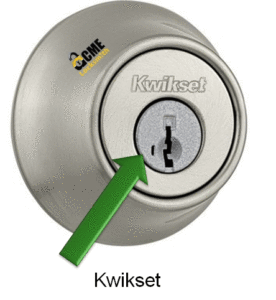
There is a lock manufacturer, Kwikset, that designed locks for residential use that you could quickly and easily rekey yourself. The product line is called SmartKey, and it’s a very different lock system that does not use pins or springs.
You can identify a Kwikset SmartKey lock by the extra little hole found near the keyhole.
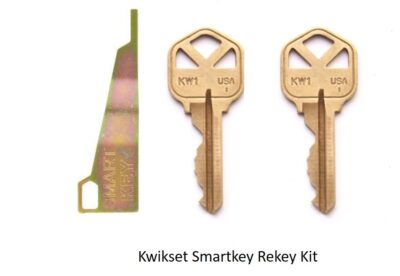
ACME Locksmith sells rekey kits for Kwikset locks on our website at a very affordable price. It comes with everything you need in order to rekey your own Kwikset locks including the smart key reset tool and new keys. You can specify how many keys you’d like to have with the kit.
Rekeying a Kwikset Smart Key DOES require the existing working key, so if you do not have this, you cannot rekey the lock. A locksmith would be able to, though, using a special tool needed to reset the lock with a working key. If you do have the working key, it’s a fairly simple process.
Video Demo – Rekey a Kwikset Lock
Demo: How to Rekey a Kwikset Smartkey LockDisclosure: As an eBay / Amazon Associate I may earn from qualifying purchases.

Leave a Reply